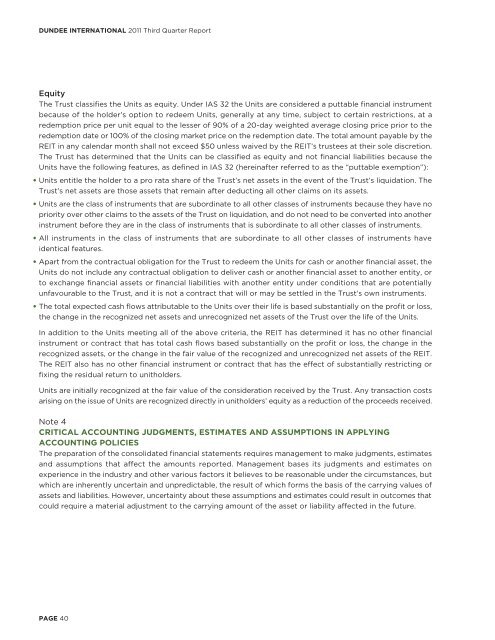DUNDEE INTERNATIONAL REIT
DUNDEE INTERNATIONAL REIT
DUNDEE INTERNATIONAL REIT
You also want an ePaper? Increase the reach of your titles
YUMPU automatically turns print PDFs into web optimized ePapers that Google loves.
<strong>DUNDEE</strong> <strong>INTERNATIONAL</strong> 2011 Third Quarter Report<br />
Equity<br />
The Trust classifies the Units as equity. Under IAS 32 the Units are considered a puttable financial instrument<br />
because of the holder’s option to redeem Units, generally at any time, subject to certain restrictions, at a<br />
redemption price per unit equal to the lesser of 90% of a 20-day weighted average closing price prior to the<br />
redemption date or 100% of the closing market price on the redemption date. The total amount payable by the<br />
<strong>REIT</strong> in any calendar month shall not exceed $50 unless waived by the <strong>REIT</strong>’s trustees at their sole discretion.<br />
The Trust has determined that the Units can be classified as equity and not financial liabilities because the<br />
Units have the following features, as defined in IAS 32 (hereinafter referred to as the “puttable exemption”):<br />
• Units entitle the holder to a pro rata share of the Trust’s net assets in the event of the Trust’s liquidation. The<br />
Trust’s net assets are those assets that remain after deducting all other claims on its assets.<br />
• Units are the class of instruments that are subordinate to all other classes of instruments because they have no<br />
priority over other claims to the assets of the Trust on liquidation, and do not need to be converted into another<br />
instrument before they are in the class of instruments that is subordinate to all other classes of instruments.<br />
• All instruments in the class of instruments that are subordinate to all other classes of instruments have<br />
identical features.<br />
• Apart from the contractual obligation for the Trust to redeem the Units for cash or another financial asset, the<br />
Units do not include any contractual obligation to deliver cash or another financial asset to another entity, or<br />
to exchange financial assets or financial liabilities with another entity under conditions that are potentially<br />
unfavourable to the Trust, and it is not a contract that will or may be settled in the Trust’s own instruments.<br />
• The total expected cash flows attributable to the Units over their life is based substantially on the profit or loss,<br />
the change in the recognized net assets and unrecognized net assets of the Trust over the life of the Units.<br />
In addition to the Units meeting all of the above criteria, the <strong>REIT</strong> has determined it has no other financial<br />
instrument or contract that has total cash flows based substantially on the profit or loss, the change in the<br />
recognized assets, or the change in the fair value of the recognized and unrecognized net assets of the <strong>REIT</strong>.<br />
The <strong>REIT</strong> also has no other financial instrument or contract that has the effect of substantially restricting or<br />
fixing the residual return to unitholders.<br />
Units are initially recognized at the fair value of the consideration received by the Trust. Any transaction costs<br />
arising on the issue of Units are recognized directly in unitholders’ equity as a reduction of the proceeds received.<br />
Note 4<br />
CRITICAL ACCOUNTING JUDGMENTS, ESTIMATES AND ASSUMPTIONS IN APPLYING<br />
ACCOUNTING POLICIES<br />
The preparation of the consolidated financial statements requires management to make judgments, estimates<br />
and assumptions that affect the amounts reported. Management bases its judgments and estimates on<br />
experience in the industry and other various factors it believes to be reasonable under the circumstances, but<br />
which are inherently uncertain and unpredictable, the result of which forms the basis of the carrying values of<br />
assets and liabilities. However, uncertainty about these assumptions and estimates could result in outcomes that<br />
could require a material adjustment to the carrying amount of the asset or liability affected in the future.<br />
PAGE 40






